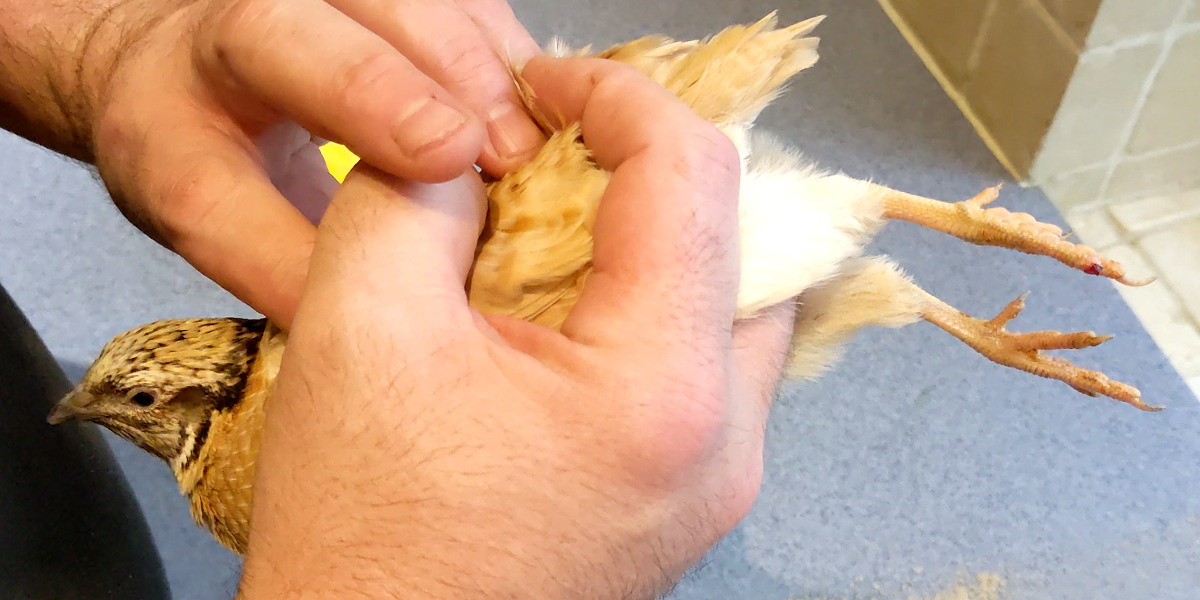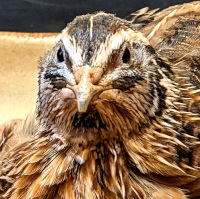Catching and holding quail safely and comfortably.

In the wild Quail are a prey animal with a natural aversion to being grabbed and held. Quail are not a fully domesticated bird species like chickens and behave differently.
Before attempting to catch quail, it's crucial to understand their behaviour. Quail are known for their skittish nature and quick movements. A quails natural reaction to being caught is to fly out of the way of danger and they can move quickly.
Approach them slowly and calmly to avoid startling them, as sudden movements can cause stress. Never make a grab for a birds wings or legs as you can break the bones of these little birds very easily.
Below: This is a short video of how I hold my Quail.
Quail should only be handled when absolutely necessary as it stresses them out considerably.
Tools and equipment you may need:
- Soft Mesh Net: A net is an easy way to catch quail and is more suitable than chasing them around with your bare hands. Opt for a net with a fine mesh to prevent injury to the quail's delicate feathers.
- Gloves: Wear lightweight gloves to protect your hands from any accidental pecks or scratches.
Steps for catching Quail:
Observation: Spend time observing the quail to identify their favourite spots and routines. This will help you anticipate their movements and make the catching process smoother.
- Prepare Your Tools: Equip yourself with a soft mesh net and wear lightweight gloves. Ensure the net has a handle long enough to reach the quail without causing them distress.
- Approach Slowly: Move toward the quail slowly and quietly. Avoid sudden movements or loud noises that could startle them. Quail are more likely to stay calm if they feel no threat.
- Use the Net: Gently position the net behind the quail, then swiftly but gently bring it forward to capture the bird. Be mindful not to trap the quail's wings in the process.
- Using your hands: When close enough, scoop the quail from underneath, cupping your hand around its body and supporting its chest with your fingers. Avoid grasping the wings or legs, which can be fragile and easily damaged.
- Secure the Quail: Once the quail is in the net, carefully lift it, supporting its body with your hands. Keep a firm but gentle grip to prevent the quail from escaping or injuring itself.
- Handling Techniques: Hold the quail close to your body with a secure yet gentle grip. Avoid squeezing too tightly, as quail have delicate bones. Keep their wings comfortably folded to prevent any injuries.
Quail do not like to held and petted and will wriggle, scratch and flap to get away.
Once secured, cradle the quail close to your body, providing warmth and security.
Your hand should cup its back, with the legs poking through your fingers.
Quail should be held tightly enough that they can not flap wildly and injure themselves but avoid constricting its wings or legs, allowing for natural movement.
Tips for comfortable holding:
Practice Patience: Quail may take some time to acclimate to being held. Practice patience and allow them to relax in your hands.
Avoid Overhandling: Limit the time you spend holding quail, especially if they show signs of stress. Regular, short handling sessions will help them become more accustomed to the experience.
Provide a Safe Environment: Create a secure and comfortable space for holding quail. Minimise loud noises and sudden movements to create a calm atmosphere.
By respecting their natural behaviour and using the right tools, you can create a comfortable environment for both you and your quail. Remember, a gentle touch and patience go a long way in fostering a positive relationship with these delightful birds.
